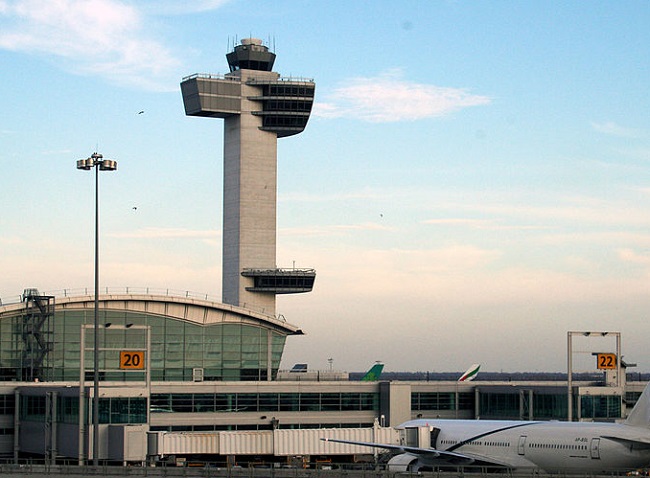Location based technology is now being used to be able to display the length of time major lines will take.
One of the world’s largest airports – the busiest one in New York – is now using geolocation beacons to be able to provide people with the actual wait times that they will face when they enter into a major lineup.
This new system will be powered by BlipTrack beacons from BLIP Systems, which is based in Denmark.
This geolocation technology beacon installation was put into place by Lockheed Martin. This system has been implemented with the intention of making it easier for passengers to make through Terminal 4 at JFK Airport. Thirteen new screens have been installed in order to display estimated processing times. These large-size screens are prominently displayed and have been installed at the checkpoints for TSA Security and Customers and Border Protection. There is also an indoor taxi lineup display.
The geolocation beacons make it possible for continual updates to be presented to travelers.
 According to the JFKAT vice president, Daryl Jameson, “It continuously updates”. JFKIAT is the company behind the operation of Terminal 4. So far, people are responding well to having the information available to them, as they know how long they will have to wait in the lines, and aren’t left wondering. As lineups aren’t an activity that most people enjoy, this “signage helps to manage expectations.”
According to the JFKAT vice president, Daryl Jameson, “It continuously updates”. JFKIAT is the company behind the operation of Terminal 4. So far, people are responding well to having the information available to them, as they know how long they will have to wait in the lines, and aren’t left wondering. As lineups aren’t an activity that most people enjoy, this “signage helps to manage expectations.”
The beacons work by conducting anonymous tracking of the mobile devices of passengers as they make their way through the airport. This way, while the individuals aren’t identified, the length of time that they spend in certain processing locations can be determined. The BlipTrack solution detects devices running on WiFi or Bluetooth and that are in “discoverable” mode, such as in tablets and smartphones.
Once one of these devices makes its way past one of the geolocation beacons, the beacon records the mobile device’s non-personal unique ID (it’s MAC address), which is then encrypted and time stamped. When that device is identified once again at other beacon locations, patterns among travelers can be established so that wait and travel times can be measured.
Passengers flying Alaska Airlines will now be able to use these new services at the L.A. International Airport
Travelers are already using mobile commerce based kiosks to be able to check in through certain airlines at the Los Angeles International Airport, but these services are about to start expanding quite significantly over the next three years, starting with Alaska Airlines.
Both airports and airlines are expected to begin making considerable investments into m-commerce.
A new survey has shown that mobile commerce kiosks are expected to take off at many different airports and through a range of airlines. In fact, the survey showed that almost 90 percent of airports intend to make an investment into this type of mobile technology within the upcoming three years. This will be good news for tech savvy travelers who are rapidly growing in numbers.
These kiosks use mobile commerce technology to allow a passenger to check in using a smartphone.
 Using this mobile technology, some of the largest airports in the world are giving travelers a way to obtain a boarding pass without having to check in with a gate agent. A recent survey conducted by SITA, a multinational technology firm, has shown that these kiosks are currently serving about 2.4 billion passengers every year. According to the chief exec at SITA, Francesco Violante, “This is the age of the connected traveler with nearly all passengers carrying mobiles, tablets and other devices.”
Using this mobile technology, some of the largest airports in the world are giving travelers a way to obtain a boarding pass without having to check in with a gate agent. A recent survey conducted by SITA, a multinational technology firm, has shown that these kiosks are currently serving about 2.4 billion passengers every year. According to the chief exec at SITA, Francesco Violante, “This is the age of the connected traveler with nearly all passengers carrying mobiles, tablets and other devices.”
Some additional key findings from this survey have shown the following:
• Almost 90 percent of airport operators that participated in the study said that they had intentions to invest in kiosks, as well as self-boarding stations and self-serve bag dropping stations within the span of the next three years. This year, alone, airports are expecting to spend about $6.8 billion on tech.
• Nearly half of the airlines that participated in the survey are able to update passengers about flight issues – such as cancellations or delays – via mobile device. By 2017, that figure is expected to rise to 97 percent.
• Under 5 percent of passengers around the globe are currently using their mobile commerce to check in, but that rate is expected to reach the 15 percent mark by 2017.
 According to the JFKAT vice president, Daryl Jameson, “It continuously updates”. JFKIAT is the company behind the operation of Terminal 4. So far, people are responding well to having the information available to them, as they know how long they will have to wait in the lines, and aren’t left wondering. As lineups aren’t an activity that most people enjoy, this “signage helps to manage expectations.”
According to the JFKAT vice president, Daryl Jameson, “It continuously updates”. JFKIAT is the company behind the operation of Terminal 4. So far, people are responding well to having the information available to them, as they know how long they will have to wait in the lines, and aren’t left wondering. As lineups aren’t an activity that most people enjoy, this “signage helps to manage expectations.”
 Using this mobile
Using this mobile 